 March 2014 March 2014
Thar She Blows!
This is not about Moby Dick. Later...
Archival storage is a unique and specialized building type, and recent experiences at the Rockefeller Archive Center provide an interesting case study of the interesting challenges of expanding this sort of facility.
The Rockefeller Archive Center, opened in 1974, is an independent operating foundation that preserves and makes available for research the archival collections of members of the Rockefeller family, institutions and organizations founded by Rockefeller family members, and many other prestigious philanthropic and service organizations such as Rockefeller University, the Ford Foundation, and the W.T. Grant Foundation. Its collection is extensive, perhaps the largest not-for-profit facility of its type in the US.
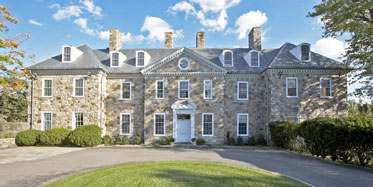
Recently, expansion of document retention of mostly paper-based material was needed; and this is where No Left Turn was called in to assist, in the role of Owner’s Representative for the build-out of the new space.
Typical Issues Related To Archival Storage
What do you need to worry about?
There are environmental concerns. Items that require evaluation typically include:
- Controlled Temperature
- Controlled Humidity
- Fire Suppression Systems
- Elimination of Environmental Contaminants
- Control of Vermin and Insect Infestation
- Control of Light Contamination
- Uninterruptible Power Supply
Then, there are space and planning considerations. What are the:
- Requirements for Inventory record-making and document labeling?
- Shelving Options?
- Means of Access, Placement, and Retrieval?
- Space Monitoring Requirements?
- Needs for Space Security?
An important factor in most archive facilities is that the contents are generally irreplaceable, and are therefore essentially uninsurable. No amount of money will recover your burnt up Magna Carta. It’s not unusual, of course, for the structure and furniture to be insured in the conventional manner. Not so with the artifacts. That’s why the protective measures are so important.
Our Project’s Solutions
In the case of this latest addition to the Rockefeller Archive, two building systems addressed the principal storage concerns.
A “Precision Air Conditioning Unit” would control temperature and humidity. In our case, this was done by using a Liebert (brand name) split system air-cooled package unit. The indoor section was placed in a mechanical room adjacent to the vault, and the outdoor section was located on the roof directly above this room. Lieberts have become the Kleenex of this type of unit, and appear to dominate the industry. Their reputation for maintaining environmental conditions within narrow bands appears justified.
Fire Suppression was addressed by using a waterless system with DuPont FM-200 gas as the suppressant. FM-200 and other similar products were developed as alternatives to Halon and other chemicals found to be ozone-depleting. Aside from the avoidance of archive-damaging water, a major benefit of FM-200 is that it is notharmful to inhabitants when discharged. (More about this later.) In our case, the pressurized tank storing the gas inliquid form was located adjacent to the Liebert unit.
Other systems related to lighting, security, and access were relatively conventional for this installation.
Construction
As the project proceeded into construction, apart from the routine issues of monitoring scheduling and quality compliance, two issues were important:
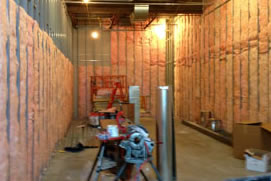 Bigger is not necessarily better. In our case, the Liebert unit and the FM-200 system were purchased well before the start of construction; and even the smallest adjustment to room layout, particularly when it affects the volume of the space, instigates engineering recalculation. Will the Liebert unit meet the needs? Is the FM-200 tank big enough, and how much suppressant will be required? Because we had to adjust the room dimensions to avoid some pre-existing structure, we had no choice but to go through this exercise. Bigger is not necessarily better. In our case, the Liebert unit and the FM-200 system were purchased well before the start of construction; and even the smallest adjustment to room layout, particularly when it affects the volume of the space, instigates engineering recalculation. Will the Liebert unit meet the needs? Is the FM-200 tank big enough, and how much suppressant will be required? Because we had to adjust the room dimensions to avoid some pre-existing structure, we had no choice but to go through this exercise.
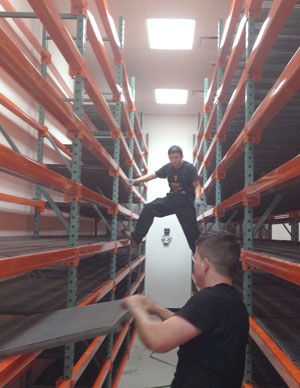 The proper functioning of the Liebert unit and the FM-200 system require a room that “doesn’t leak”. While complete air-tightness may not be essential, the released FM-200 gas has to be contained well enough to put out a fire, which may be at any level within the archive. Wall, floor, and ceiling intersections must be tight. Doors have to be gasketed. Ceiling tiles must be sealed and held down. And fire dampers must close properly. We had to be vigilant about all of these. The proper functioning of the Liebert unit and the FM-200 system require a room that “doesn’t leak”. While complete air-tightness may not be essential, the released FM-200 gas has to be contained well enough to put out a fire, which may be at any level within the archive. Wall, floor, and ceiling intersections must be tight. Doors have to be gasketed. Ceiling tiles must be sealed and held down. And fire dampers must close properly. We had to be vigilant about all of these.
Other Stuff
Had this project been more elaborate, we may well have had other systems and factors rise to the level of “Critical”. Not so much, in this case.
- We fully insulated the vault room.
- We used keys to lock and unlock.
- Building intrusion security was handled with a remote monitored alarm system.
- We put in Internet service, with wireless hubs for user connectivity.
- We had security cameras linked to the Internet.
- We installed wireless space condition monitors, also connected to the Internet.
- We determined the building had adequate power back-up.
- We bought warehouse-style pallet rack shelving, with custom deck surfaces.
All of this, of course, was done in a way that merged into the pre-existing protocols of the Archive Center.
Every Project Needs A Good “War” Story
Well, maybe… Here’s ours:
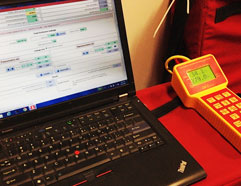 Room integrity is tested by installing a door blower fan to run both “in” and “out” for positive and negative pressure. While running, sensors read pressure levels and duration. Then, industry standard software calculates the height to which FM-200 gas is effective as a suppressant. In our case, this would be to the height of the top box sitting on the top shelf. Room integrity is tested by installing a door blower fan to run both “in” and “out” for positive and negative pressure. While running, sensors read pressure levels and duration. Then, industry standard software calculates the height to which FM-200 gas is effective as a suppressant. In our case, this would be to the height of the top box sitting on the top shelf.
First time – failure. Now, what?
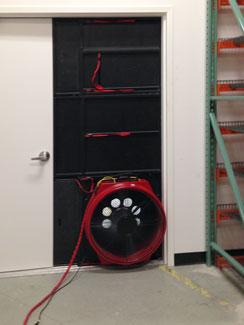 Before the failed test, we had decided to change the light fixtures. We had also purchased the shelving assembly, which had not yet been installed. Taking a bit of a gamble, we chose to change out the light fixtures, double-check the tile ceiling construction, and install the shelving. Before the failed test, we had decided to change the light fixtures. We had also purchased the shelving assembly, which had not yet been installed. Taking a bit of a gamble, we chose to change out the light fixtures, double-check the tile ceiling construction, and install the shelving.
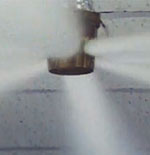 On the day of the re-test, I was alone in the vault when the technician poked his head through the fan opening, and asked me to open a safety cover and push a particular button to trip the fire dampers. The ensuing alarm sirens’ blare and the gas spewing from the ceiling had the people standing outside all excited, screaming “Get out! Get out! Get out!” (See newsletter title above.) On the day of the re-test, I was alone in the vault when the technician poked his head through the fan opening, and asked me to open a safety cover and push a particular button to trip the fire dampers. The ensuing alarm sirens’ blare and the gas spewing from the ceiling had the people standing outside all excited, screaming “Get out! Get out! Get out!” (See newsletter title above.)
Turns out, the technician had forgotten to disconnect the FM-200 gas release mechanism during the test. “Now, there was a $10,000 mistake” said the Contractor. A sad day for the chagrined sub-contractor who had to absorb the cost.
Two weeks later, the second re-test passed. Thankfully.
The Moral Of Our Story?
Perhaps, there is none really. But, there may be lessons learned:
- Certain building types have interesting and unique challenges.
- A good Owner’s Rep can help steer a project in a positive direction.
- Not everything goes as planned. It’s how well you recover that matters.
- The Rockefeller Archive Center is devoted to quality.
Pursuit of correctness is a legitimate endeavor.
Missed earlier newsletters? Find them here:
November 2013 “Giving Thanks”
September 2013 “Back to School?”
June 2013 “What Time is It?”
March 2013 “Acey Deucey?”
January 2013 “A Swamp Full of Alligators”
October 2012 “Plan to Live Forever, Part Deux”
July 2012 “A Midsummer Dream”
May 2012 “Are you Virtually Working?”
March 2012 “Your Huddled Masses”
January 2012 “Observing Observations”
October 2011 “I Want What I Want”
August 2011 “A Beach Read”
May 2011 “NeoLuddite or Technophile?”
March 2011 “Do Your Silos Leak?”
January 2011 “Plan to Live Forever!”
November 2010 “May I Have A Plan, Master?”
September 2010 “How do we choose?”
July 2010 “Good People Behaving Badly”
May 2010 “LEED: LEADing or Dead Weight?”
March 2010 “Why does it cost so much?”
January 2010 “Design/Builders show us your softer side.”
November 2009 “What the Facilities?”
September 2009 “Why Do Architects Make Good Owner’s Reps?” |

 March 2014
March 2014

 The proper functioning of the Liebert unit and the FM-200 system require a room that “doesn’t leak”. While complete air-tightness may not be essential, the released FM-200 gas has to be contained well enough to put out a fire, which may be at any level within the archive. Wall, floor, and ceiling intersections must be tight. Doors have to be gasketed. Ceiling tiles must be sealed and held down. And fire dampers must close properly. We had to be vigilant about all of these.
The proper functioning of the Liebert unit and the FM-200 system require a room that “doesn’t leak”. While complete air-tightness may not be essential, the released FM-200 gas has to be contained well enough to put out a fire, which may be at any level within the archive. Wall, floor, and ceiling intersections must be tight. Doors have to be gasketed. Ceiling tiles must be sealed and held down. And fire dampers must close properly. We had to be vigilant about all of these. Room integrity is tested by installing a door blower fan to run both “in” and “out” for positive and negative pressure. While running, sensors read pressure levels and duration. Then, industry standard software calculates the height to which FM-200 gas is effective as a suppressant. In our case, this would be to the height of the top box sitting on the top shelf.
Room integrity is tested by installing a door blower fan to run both “in” and “out” for positive and negative pressure. While running, sensors read pressure levels and duration. Then, industry standard software calculates the height to which FM-200 gas is effective as a suppressant. In our case, this would be to the height of the top box sitting on the top shelf. Before the failed test, we had decided to change the light fixtures. We had also purchased the shelving assembly, which had not yet been installed. Taking a bit of a gamble, we chose to change out the light fixtures, double-check the tile ceiling construction, and install the shelving.
Before the failed test, we had decided to change the light fixtures. We had also purchased the shelving assembly, which had not yet been installed. Taking a bit of a gamble, we chose to change out the light fixtures, double-check the tile ceiling construction, and install the shelving. On the day of the re-test, I was alone in the vault when the technician poked his head through the fan opening, and asked me to open a safety cover and push a particular button to trip the fire dampers. The ensuing alarm sirens’ blare and the gas spewing from the ceiling had the people standing outside all excited, screaming “Get out! Get out! Get out!” (See newsletter title above.)
On the day of the re-test, I was alone in the vault when the technician poked his head through the fan opening, and asked me to open a safety cover and push a particular button to trip the fire dampers. The ensuing alarm sirens’ blare and the gas spewing from the ceiling had the people standing outside all excited, screaming “Get out! Get out! Get out!” (See newsletter title above.)